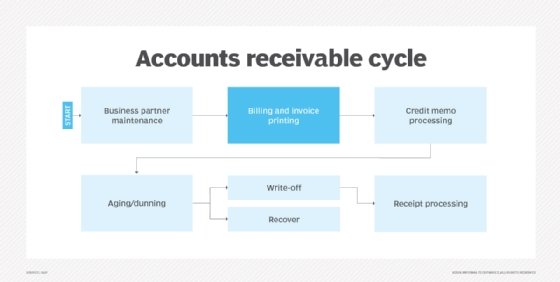accounts receivable (AR)
What is accounts receivable (AR)?
Accounts receivable (AR) is an item in the general ledger (GL) that shows money owed to a business by customers who have purchased goods or services on credit.
AR is the opposite of Accounts payable, which are the bills a company needs to pay for the goods and services it buys from a vendor.
Why accounts receivable is important
AR is a vital part of a balance sheet because it represents bills that should be paid to a company and could require steps for collection.
Payments of accounts receivable can cut a company's debt, reduce financing charges and improve cash flow, which can be used to hike dividends, invest in Capex (capital expenditure), increase risk capital or offer new goods and services.
The AR process
The AR process starts when a company sells a good or service and includes payment terms, discounts or credit guidelines in an invoice to the customer. When payments arrive, receipts need to be returned and the payment needs to be recorded.
Companies need to have meticulous rules for issuing credit and collecting a debt in a timely manner, and they need to keep good data on customers. To maintain accurate accounts receivable, payments also need to be applied to the correct customer and precise invoice.
A company might have a clerk for AR whose duties include tracking accounts to determine if they are overdue, calling customers to speed payments, responding to questions from customers, maintaining accurate records and bookkeeping.
A company's collections department would use an aging report to track and list unpaid invoices by customers and the time for the existence of the bill, usually in increments of 30, 60, 90 days or more. An aging report is a way to determine if a company is doing a good job of collecting bills and reducing accounts receivables.
Also, numerous vendors, including Oracle, Workday and SAP, sell software for automating management of accounts receivable and integrating the process with an ERP (enterprise resource planning) system.

The accounts receivable turnover ratio
Companies can also leverage their receivables with AR financing, or the use of unpaid bills as an asset to obtain credit.
In seeking to win credit backed by the money it is owed, a company's accounts receivable turnover ratio becomes an important factor. The ratio counts the number of times a company collects its average AR over a year and is a way to determine a company's skill at converting receivables into cash. A bank, for example, might look at the ratio to determine the likelihood of being repaid or set an interest rate for loaning money to a company based on its accounts receivables.
AR factoring
AR is also important because it can be sold by a company to a "factor," such as a bank or other financier.
Factoring, or the sale of accounts receivable, raises money for a company and boosts the seller's cash flow, but it also involves paying a fee to the factoring company in return for the faster payment of accounts receivable. The factor pays the original company for its AR and then collects the money due from customers.
Sometimes a bill cannot be collected and a company would apply GAAP (generally accepted accounting principles) to cancel the bad debt.







